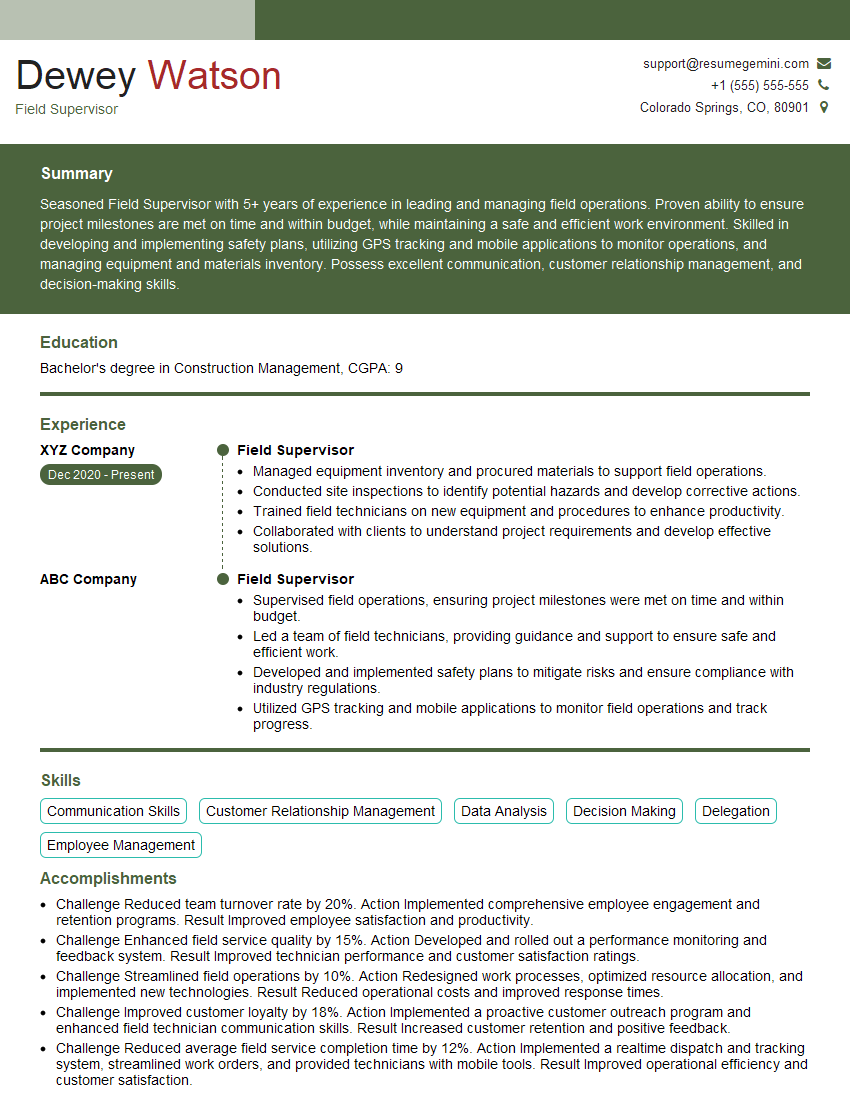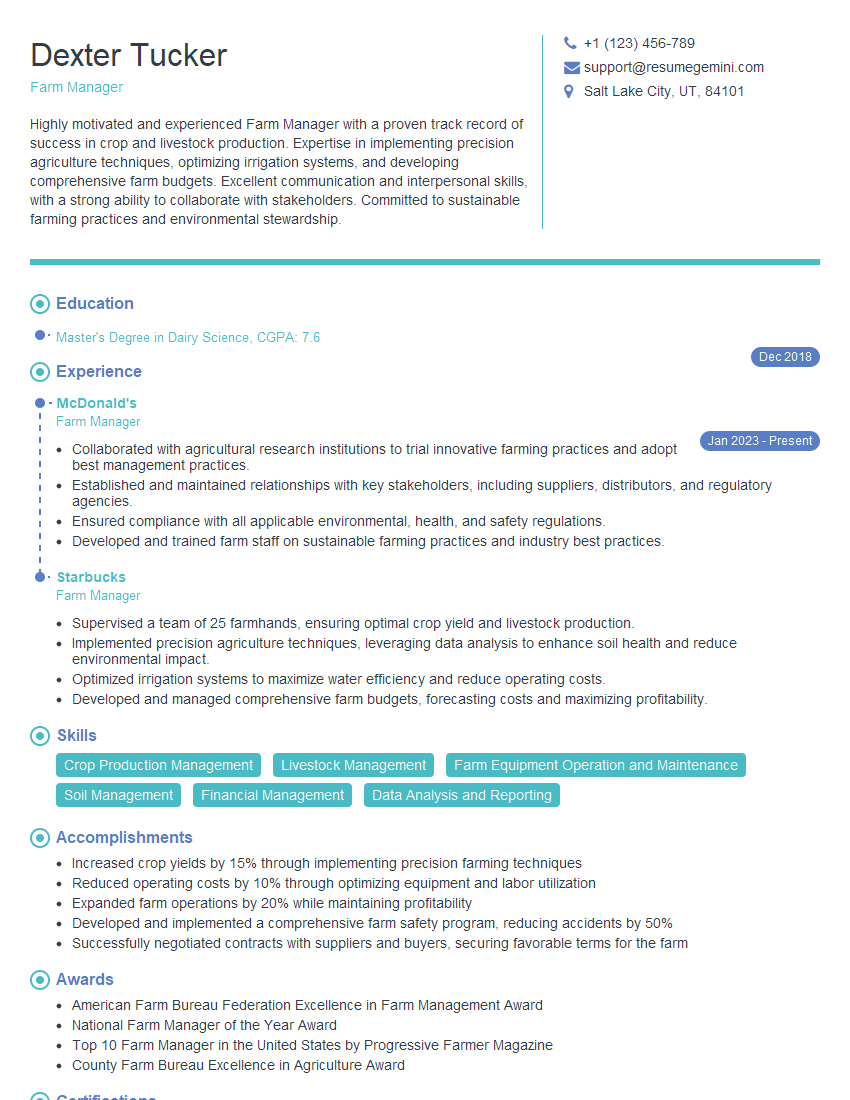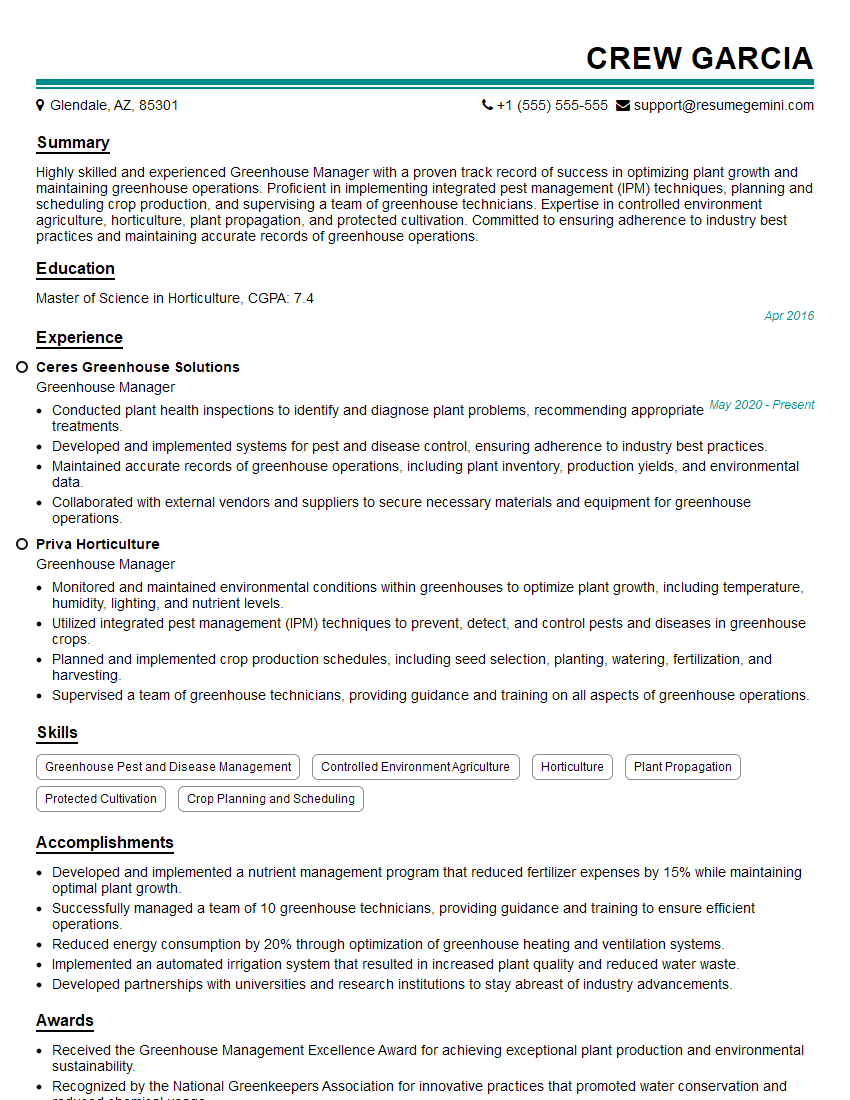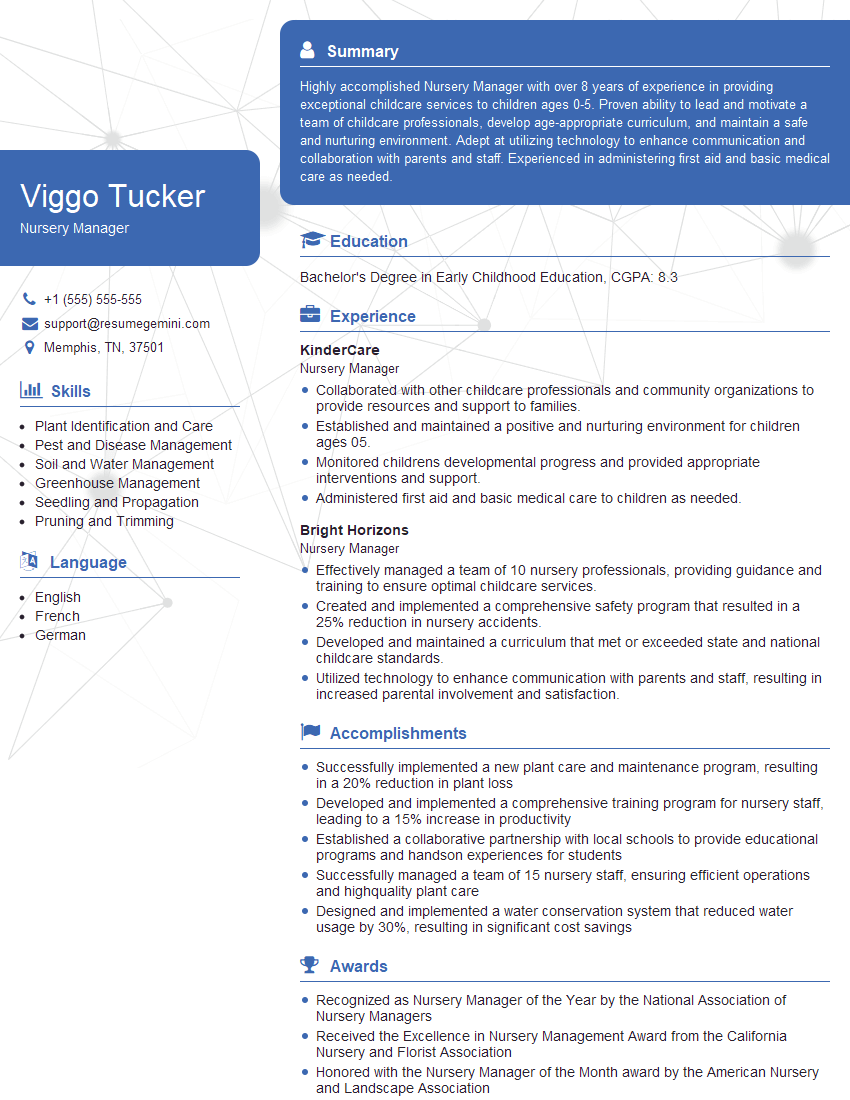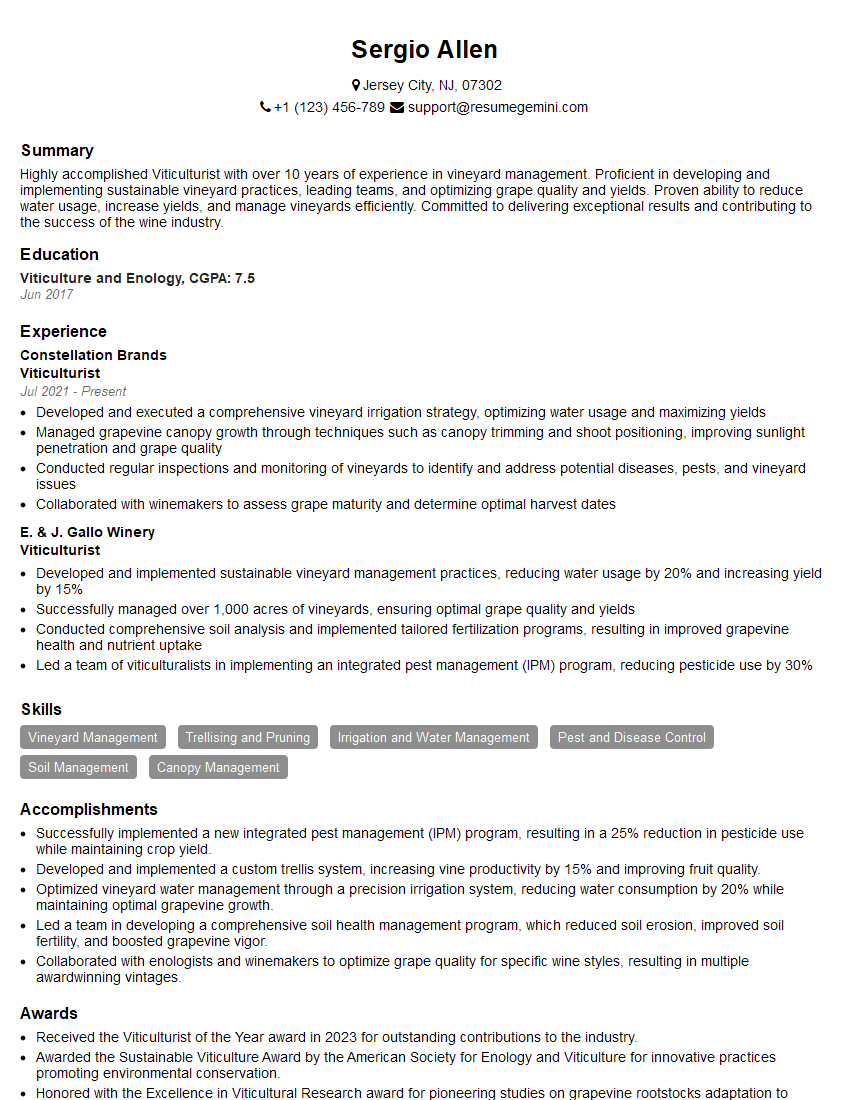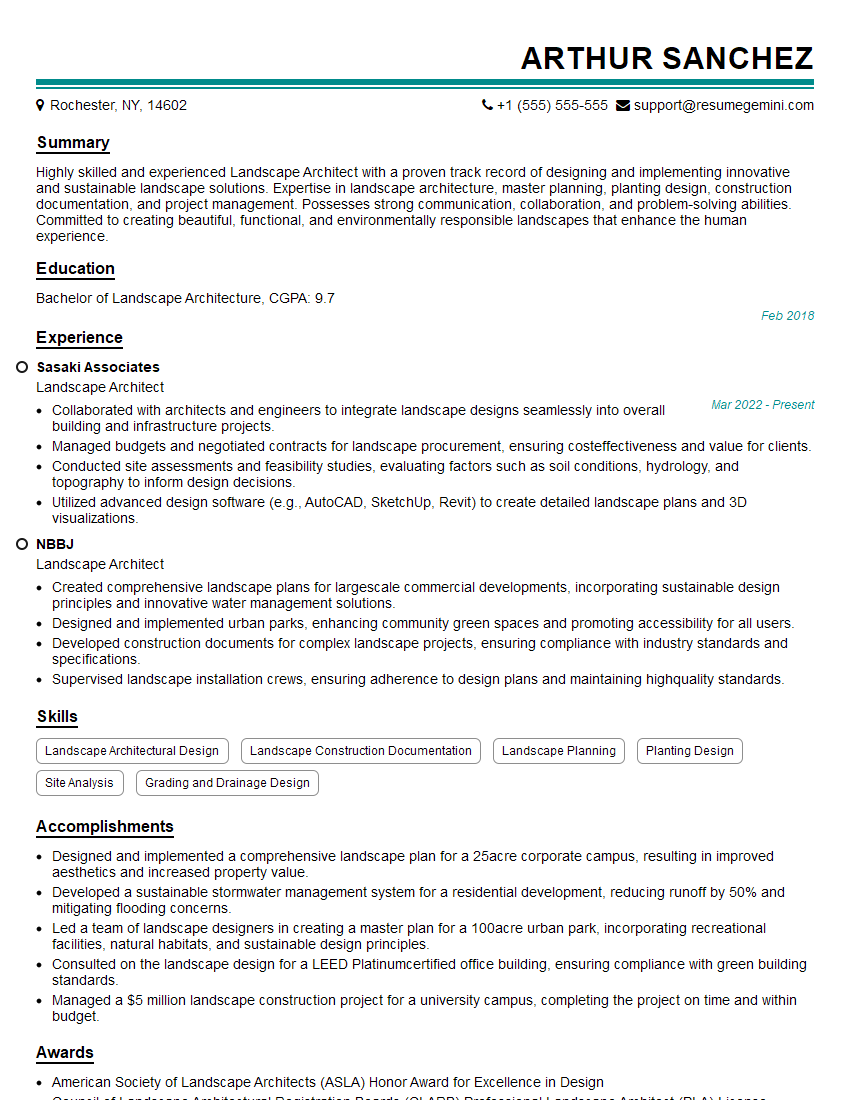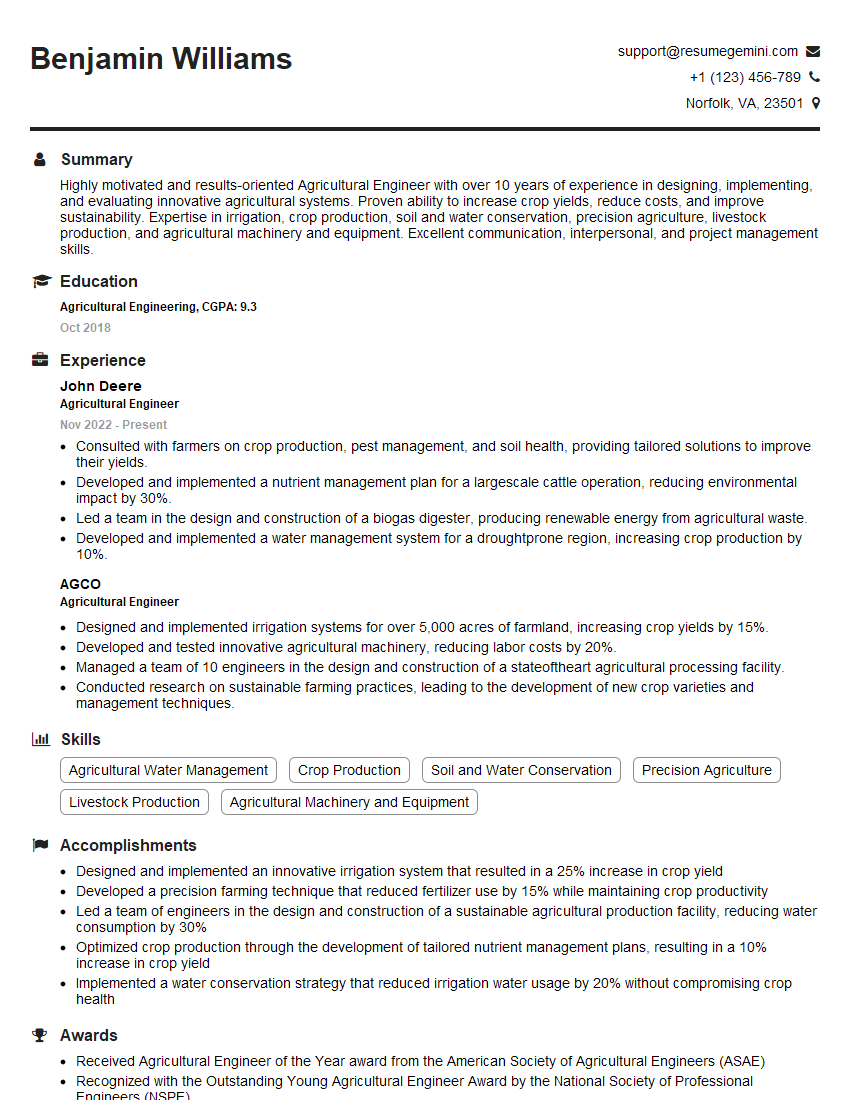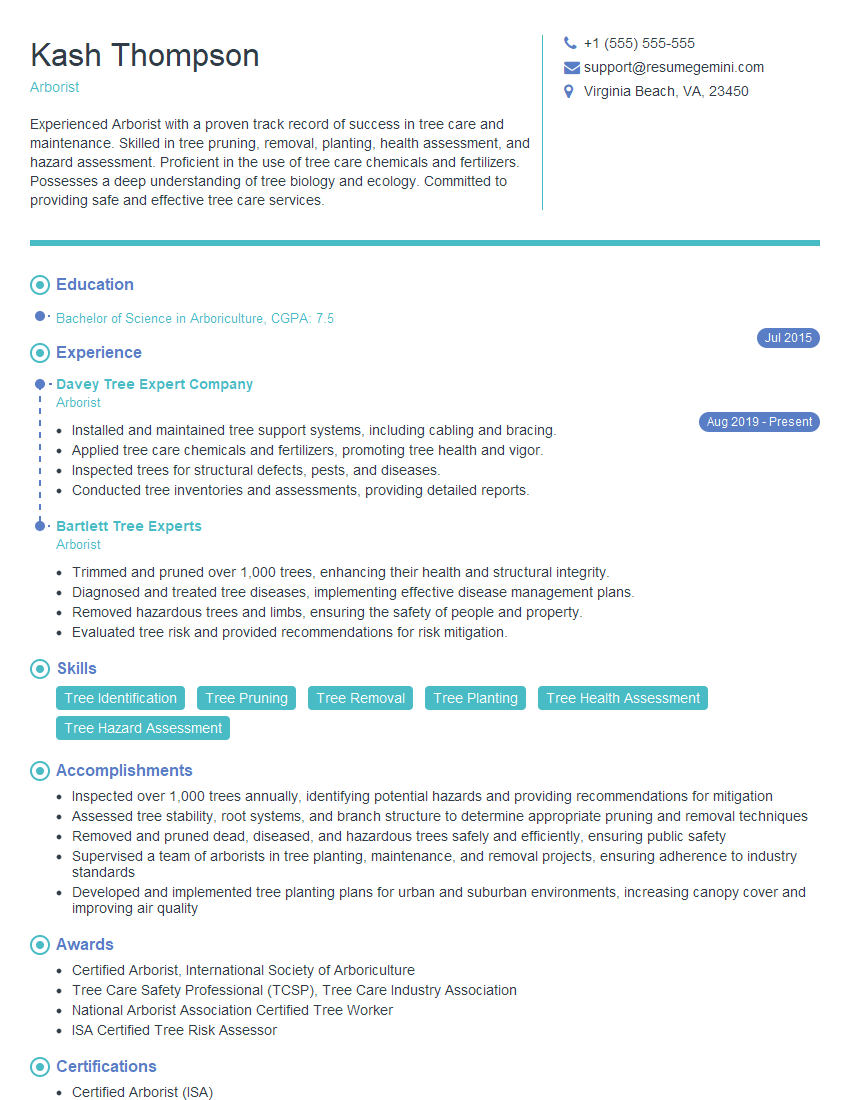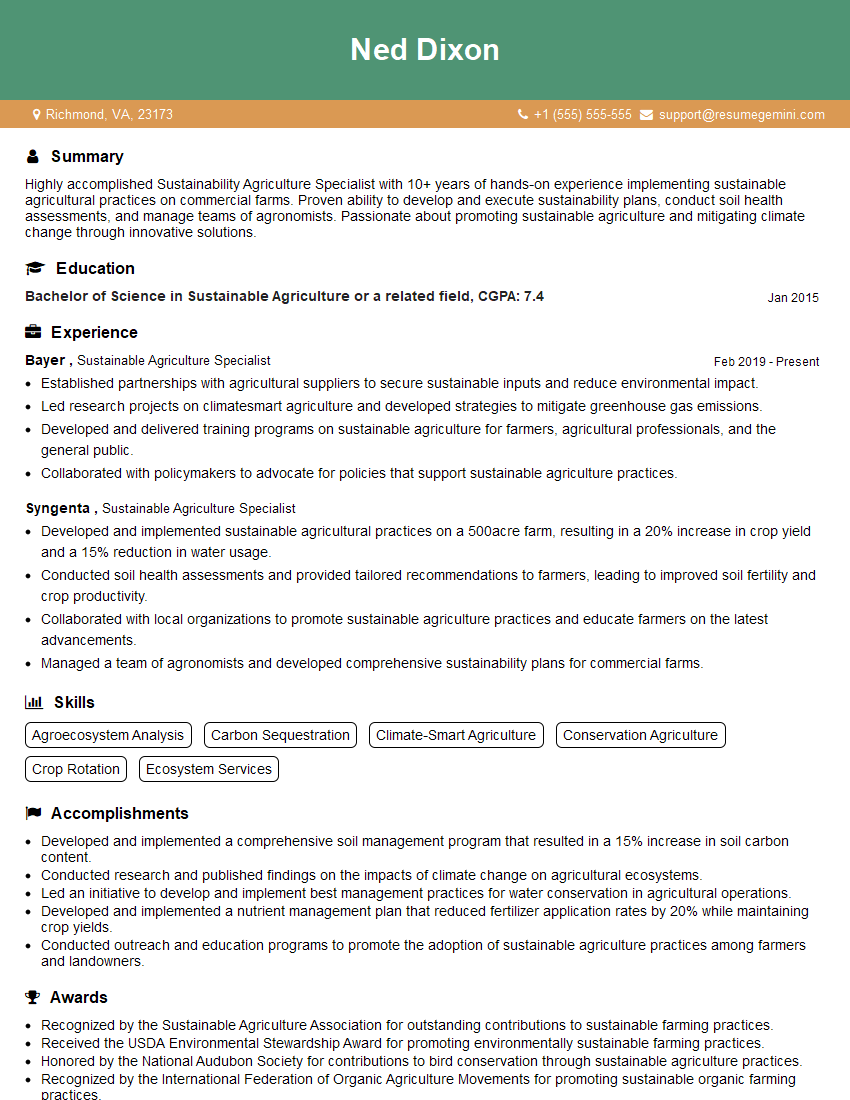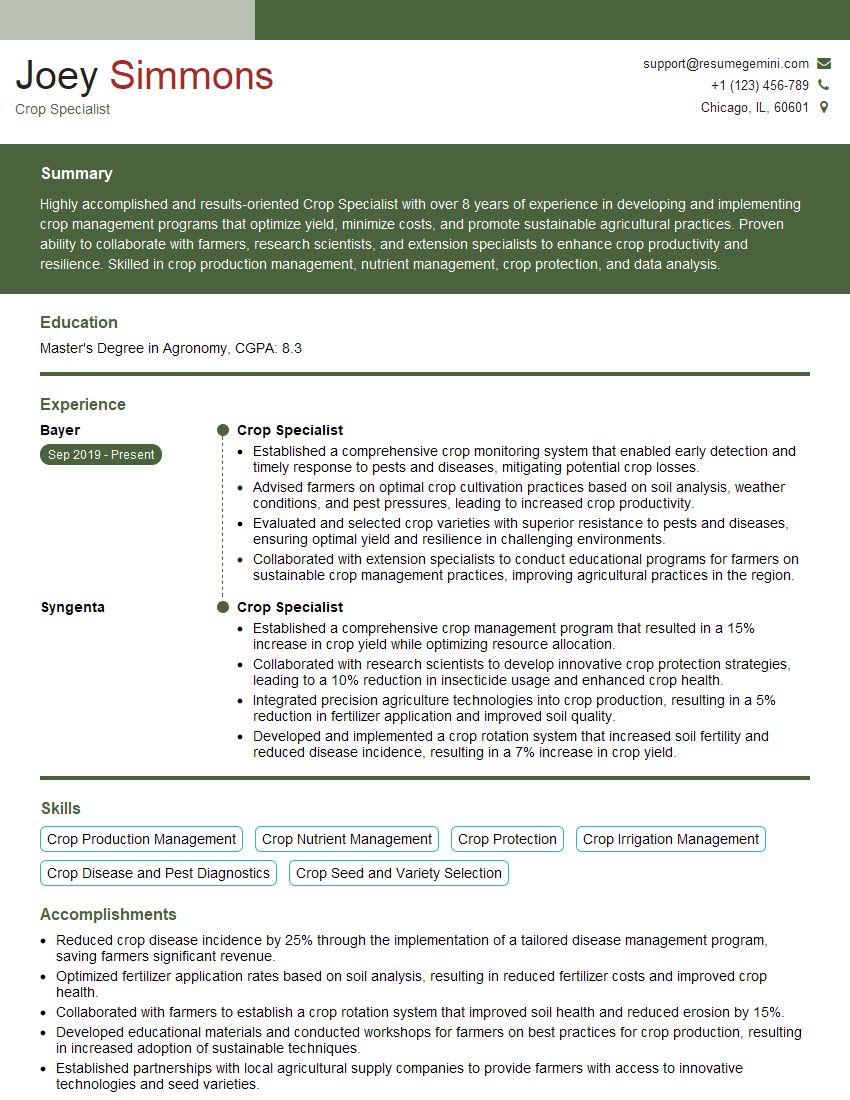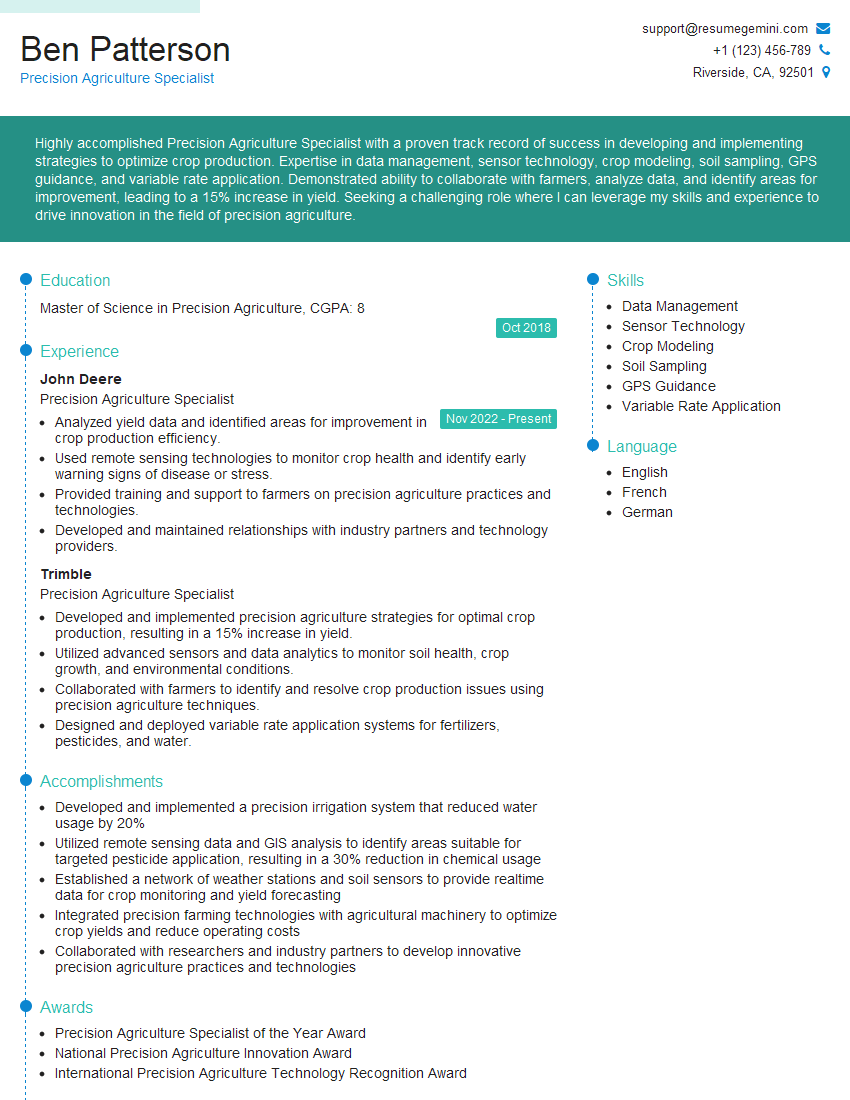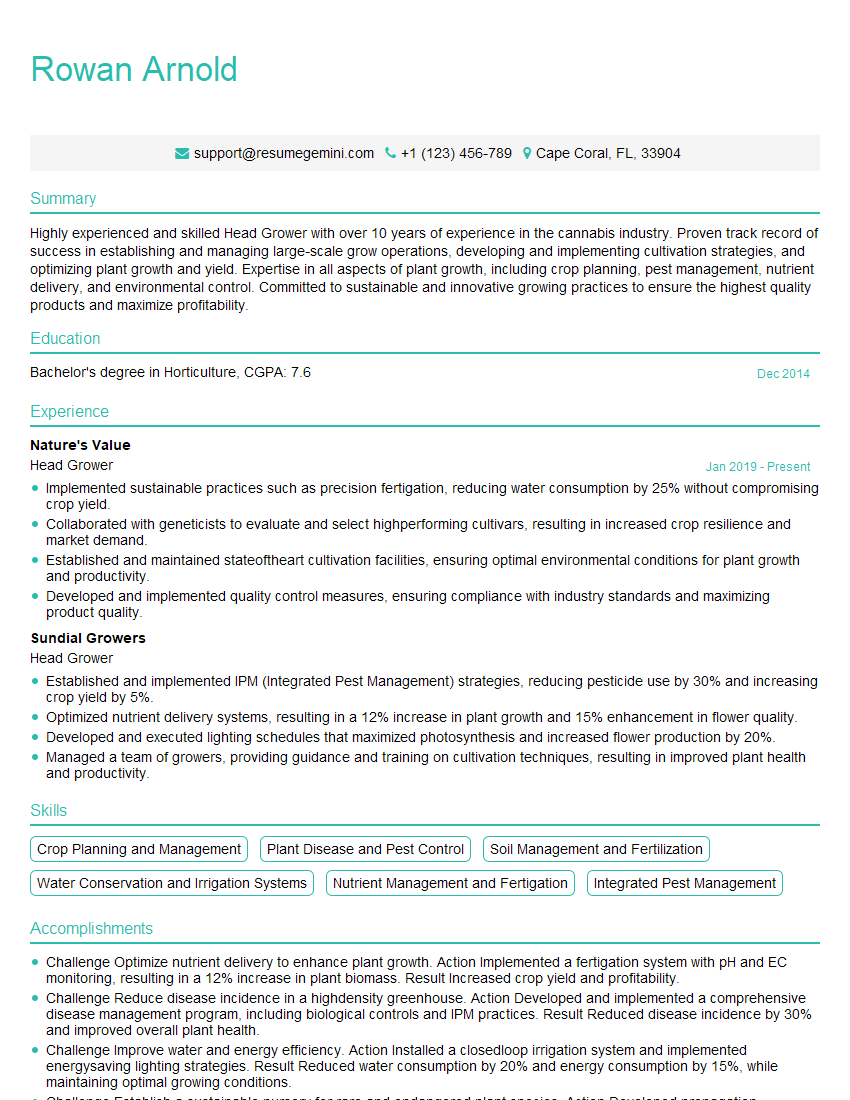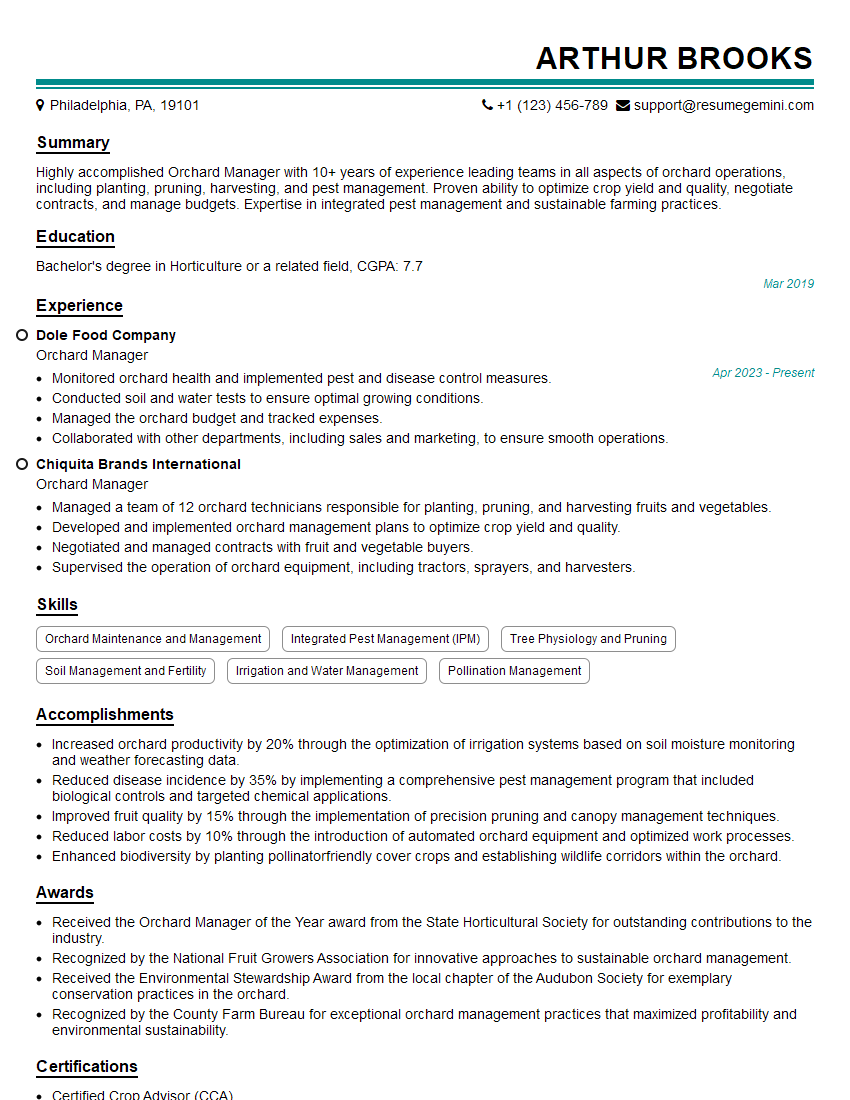Preparation is the key to success in any interview. In this post, we’ll explore crucial Trellising and Canopy Management interview questions and equip you with strategies to craft impactful answers. Whether you’re a beginner or a pro, these tips will elevate your preparation.
Questions Asked in Trellising and Canopy Management Interview
Q 1. Explain the different types of trellising systems.
Trellising systems provide support for climbing crops, improving fruit quality and yield. They vary greatly depending on crop needs and the available space. Common types include:
- Vertical Trellises: These are the most common and consist of vertical wires or strings strung between posts. They’re ideal for vining crops like cucumbers and tomatoes.
- Horizontal Trellises: These use horizontal wires or supports, often used for crops that sprawl or require more lateral growth, such as melons.
- A-frame Trellises: These are free-standing structures forming an ‘A’ shape, providing support across a wider area. Suitable for larger plants or those requiring more space.
- Oblique Trellises: These systems use angled supports, offering a compromise between vertical and horizontal support, minimizing shading and optimizing sun exposure.
- Living Trellises: These involve training plants to climb on naturally growing shrubs or trees. This approach is often used in permaculture systems or smaller gardens.
The choice of trellis depends heavily on the crop’s growth habit, space constraints, and the grower’s resources.
Q 2. What are the advantages and disadvantages of each trellising system?
Each trellising system has its advantages and disadvantages:
- Vertical Trellises:
- Advantages: Maximize space utilization, excellent air circulation, easy fruit harvesting.
- Disadvantages: Requires sturdy posts and wires, may not be suitable for heavy crops.
- Horizontal Trellises:
- Advantages: Supports sprawling crops, minimizes fruit damage from contact with the ground.
- Disadvantages: Can be more labor-intensive to manage, requires more space.
- A-frame Trellises:
- Advantages: Provides wide support, easy access for harvesting and pruning.
- Disadvantages: Requires more materials, can be costly to construct.
- Oblique Trellises:
- Advantages: Good balance of space utilization and sun exposure.
- Disadvantages: Can be more complex to design and install.
- Living Trellises:
- Advantages: Natural, aesthetically pleasing, low maintenance (once established).
- Disadvantages: Requires careful plant selection, limited control over growth.
Q 3. How do you select the appropriate trellising system for a specific crop?
Selecting the appropriate trellising system involves considering several factors:
- Crop characteristics: Growth habit (vining, sprawling), weight of fruit, required spacing.
- Climate: Wind exposure, rainfall, temperature fluctuations influence trellis strength and design.
- Space availability: The size of the planting area determines the trellis type and dimensions.
- Budget and resources: Material costs, labor availability, and the grower’s skills will influence the feasibility of different systems.
- Aesthetic considerations: In some cases, the trellis’s visual impact might be a factor.
For example, tomatoes, with their upright growth and relatively heavy fruit, often benefit from strong vertical trellises. Meanwhile, melons, which spread horizontally, may require a horizontal or A-frame trellis.
Q 4. Describe the process of installing a trellis system.
Installing a trellis involves these steps:
- Planning and design: Determine the type of trellis, size, and materials needed based on crop and site conditions.
- Material selection: Choose durable and appropriate materials like sturdy posts (wood or metal), strong wire or twine, and fasteners.
- Site preparation: Clear the area, prepare the soil, and mark out the trellis location.
- Post installation: Set posts firmly in the ground using concrete or other anchoring methods.
- Wire or string installation: Stretch and fasten the support wires or strings according to the chosen design.
- Final checks: Ensure stability and strength of the trellis before planting.
It’s crucial to ensure the posts are firmly anchored to withstand wind and the weight of the crop.
Q 5. How do you maintain a trellis system?
Maintaining a trellis system involves regular inspections and repairs:
- Regular inspections: Check for loose wires, broken posts, or signs of wear and tear.
- Repair and replacement: Repair or replace damaged components promptly to prevent collapse.
- Cleaning: Remove weeds and debris from around the trellis base.
- Pruning and training: Guide the plants along the trellis, removing excess growth as needed to maintain optimal light penetration and airflow.
- Seasonal adjustments: In colder climates, winterizing the trellis may be necessary to protect it from snow and ice damage.
Regular maintenance will extend the lifespan of the trellis and improve crop yields.
Q 6. What are the key principles of canopy management?
Canopy management refers to the practices used to control the growth and development of a plant’s canopy, the leafy part above the ground. The key principles include:
- Light interception: Maximizing light capture for photosynthesis while avoiding excessive shading.
- Air circulation: Improving airflow within the canopy to reduce disease and pest problems.
- Fruit exposure: Ensuring adequate sunlight reaches the fruit for optimal coloration, sugar development, and ripening.
- Structural integrity: Maintaining a strong and stable canopy to support fruit weight and resist wind damage.
- Water management: Controlling canopy density to affect transpiration rates and water stress.
Think of it as carefully sculpting the plant to optimize its performance.
Q 7. How does canopy management affect fruit quality and yield?
Effective canopy management significantly impacts fruit quality and yield. A well-managed canopy:
- Increases fruit size and quality: Better light penetration leads to improved sugar content, color, and flavor.
- Improves yield: By maximizing light interception and minimizing shading, more fruit can develop.
- Reduces disease and pest pressure: Increased air circulation reduces humidity and inhibits the spread of diseases and pests.
- Enhances fruit ripening: Improved sun exposure promotes even ripening.
- Reduces fruit damage: A well-supported canopy minimizes fruit damage from contact with the ground.
Conversely, poor canopy management can result in smaller, lower-quality fruit, reduced yields, and increased susceptibility to diseases and pests. Imagine a dense, poorly managed canopy; the fruits at the bottom never see the sun and rot before ripening.
Q 8. Explain the different canopy management techniques.
Canopy management encompasses a range of techniques aimed at optimizing the plant’s architecture for improved yield, fruit quality, and overall plant health. These techniques are crucial for maximizing sunlight penetration, airflow, and pest and disease control.
- Pruning: This involves selectively removing branches, shoots, and leaves to shape the plant and improve light penetration. Different pruning styles exist, such as heading (cutting back the terminal bud) and thinning (removing entire branches).
- Training: This focuses on guiding the plant’s growth into a desired structure using trellising systems or other supports. This can include techniques like bending, tying, and positioning shoots to optimize light interception.
- Shoot Positioning: Strategically directing the growth of new shoots to ensure even canopy distribution and prevent overcrowding.
- Leaf Removal (Defoliation): Removing leaves, often near fruit clusters, to improve sunlight penetration and airflow, thereby reducing disease incidence and improving fruit ripening.
- Growth Regulators: Applying plant growth regulators (PGRs) to control vegetative growth and encourage flowering and fruiting. This requires careful consideration and precise application.
The specific techniques used depend heavily on the crop type, its growth habit, and the overall growing environment.
Q 9. How do you assess the need for pruning and training?
Assessing the need for pruning and training involves a thorough evaluation of the plant’s current state and its desired future form. I use a multi-pronged approach:
- Visual Inspection: I carefully observe the canopy’s density, shoot distribution, and overall structure. Overcrowding, excessive shading, or weak, unproductive branches indicate a need for intervention.
- Growth Monitoring: Tracking the plant’s growth rate and patterns over time helps predict future canopy development and allows for proactive management.
- Yield Analysis: Analyzing previous yields and correlating them with canopy characteristics helps identify areas for improvement. For example, low yield in shaded areas might indicate the need for more aggressive pruning to improve light penetration.
- Environmental Factors: Considering factors like light availability, wind exposure, and potential pest pressures helps determine the appropriate level of intervention. A plant in a densely shaded area might require more aggressive pruning than one in full sun.
My decision-making process is data-driven and aims for a balance between vigorous growth and optimal fruit production. For example, a young plant might require more training to establish a strong framework, while a mature plant might need primarily pruning for maintenance.
Q 10. Describe your experience with shoot positioning and leaf removal.
Shoot positioning and leaf removal are crucial for optimizing light interception and airflow within the canopy. My experience involves using these techniques in a variety of crops, including grapes and tomatoes.
Shoot Positioning: In grapevines, for instance, I carefully position shoots along the trellis wire to ensure even spacing and maximize sunlight exposure for each fruit cluster. This involves tying shoots to the wires and removing any competing shoots. This precise positioning is key for maximizing yield and fruit quality.
Leaf Removal: Leaf removal is a delicate balance. Excessive leaf removal can stress the plant, while insufficient removal hinders light penetration. I carefully assess the canopy density and remove leaves selectively, often focusing on leaves shading the fruit clusters. This is particularly important for improving fruit color, ripening, and reducing disease incidence. In tomatoes, for instance, removing lower leaves allows for better airflow, preventing fungal diseases. The extent of leaf removal depends on factors such as the crop’s growth stage, environmental conditions, and the variety.
I always monitor the plant’s response to these interventions, adjusting my approach as needed to prevent stress or negative impacts on yield.
Q 11. How do you manage canopy density?
Managing canopy density is about striking a balance between sufficient leaf area for photosynthesis and adequate light penetration and airflow to reduce disease and improve fruit quality. Overly dense canopies can lead to shading, poor fruit development, and increased susceptibility to diseases. Conversely, excessively sparse canopies can reduce overall yield.
My approach involves a combination of techniques:
- Pruning: Regularly removing excess shoots and branches to maintain the desired density.
- Training: Using trellising systems to guide the plant’s growth into a more open structure.
- Leaf Removal: Removing leaves strategically to improve light penetration and airflow.
- Growth Regulators: In some cases, applying PGRs to moderate vegetative growth and control canopy density.
I utilize light meters to quantitatively assess light penetration within the canopy, guiding my decisions regarding pruning and leaf removal to achieve optimal light levels.
Q 12. How do you deal with excessive vegetative growth?
Excessive vegetative growth can overshadow fruiting and lead to lower yields and poor fruit quality. Managing this requires a multifaceted approach:
- Pruning: Removing excess shoots and branches to redirect energy towards fruiting.
- Growth Regulators: Applying PGRs to suppress vegetative growth and promote flowering and fruiting. This requires careful consideration of the specific PGR, its application method, and the plant’s growth stage.
- Nutrient Management: Ensuring a balanced nutrient supply. Excessive nitrogen can stimulate vegetative growth at the expense of fruiting, while proper nutrient balance will support both growth and fruiting.
- Water Management: Avoid overwatering, as this can promote excessive vegetative growth.
For example, in a situation with excessively vigorous vine growth in grapes, I’d utilize a combination of shoot thinning, heading back vigorous shoots, and potentially PGR application to control vegetative growth and increase fruit production.
Q 13. How do you prevent shading and improve light penetration?
Shading within the canopy significantly reduces photosynthetic efficiency and fruit quality. Improving light penetration is crucial for optimal production. My strategies include:
- Pruning: Thinning out crowded branches and removing shaded leaves.
- Training: Optimizing the plant’s structure using trellises or other support systems to ensure even light distribution.
- Leaf Removal: Removing leaves strategically to allow more light to reach the fruit.
- Row Spacing: Ensuring adequate spacing between rows to maximize sunlight exposure.
I often use light meters to measure light penetration within the canopy, helping to quantify the effectiveness of my interventions and guide further adjustments.
Q 14. Explain the role of irrigation in canopy management.
Irrigation plays a vital, albeit indirect, role in canopy management. Proper irrigation helps to maintain optimal plant vigor and health, which directly influences canopy development and management needs.
- Uniform Growth: Consistent and adequate water supply ensures uniform growth, making canopy management more predictable and efficient. Uneven watering can lead to uneven growth and make canopy management more complex.
- Stress Avoidance: Water stress can trigger compensatory vegetative growth, potentially negating efforts to control canopy density.
- Disease Prevention: Adequate irrigation helps maintain plant health and reduces susceptibility to diseases, particularly those favored by high humidity conditions within a dense canopy.
Therefore, by maintaining optimal water availability, I can minimize the need for aggressive interventions such as extensive pruning and potentially reduce stress on the plant.
Q 15. How does canopy management affect disease and pest control?
Canopy management significantly impacts disease and pest control. A well-managed canopy promotes good air circulation and sunlight penetration, reducing humidity and creating an environment less favorable for the growth of many fungal diseases and pests. Think of it like this: a dense, overcrowded canopy is like a humid greenhouse, perfect for disease to thrive. Conversely, a properly managed canopy is more like a well-ventilated home, much less hospitable to disease and pests.
- Reduced Humidity: Good air circulation minimizes humidity build-up, reducing the incidence of fungal diseases like powdery mildew and downy mildew, common in grapes and cucurbits.
- Improved Sunlight Penetration: Adequate sunlight prevents damp, shaded areas where pathogens can flourish and weakens plants, making them more susceptible to disease.
- Easier Pest Monitoring: An open canopy makes it easier to spot and address pest infestations early on. You can easily visually inspect leaves and fruits for signs of pests.
- Targeted Pesticide Application: Effective canopy management reduces the amount of pesticide needed. When plants are open, spray coverage is more efficient.
Career Expert Tips:
- Ace those interviews! Prepare effectively by reviewing the Top 50 Most Common Interview Questions on ResumeGemini.
- Navigate your job search with confidence! Explore a wide range of Career Tips on ResumeGemini. Learn about common challenges and recommendations to overcome them.
- Craft the perfect resume! Master the Art of Resume Writing with ResumeGemini’s guide. Showcase your unique qualifications and achievements effectively.
- Don’t miss out on holiday savings! Build your dream resume with ResumeGemini’s ATS optimized templates.
Q 16. How do you monitor the effectiveness of canopy management practices?
Monitoring the effectiveness of canopy management relies on a combination of visual assessments and data collection. We need to track key indicators throughout the growing season.
- Visual Inspections: Regularly assess canopy structure, noting leaf area index (LAI), light penetration, and the presence of diseases or pests. Photography is often used for documentation and comparison.
- Data Collection: Measurements like fruit size, yield, and quality parameters like sugar content (brix) in grapes or firmness in tomatoes are crucial indicators of canopy management success. Data loggers can monitor temperature and humidity levels within the canopy.
- Disease and Pest Incidence: Record the occurrence and severity of diseases and pests throughout the growing season. This data is crucial to adjusting management practices.
- Yield Analysis: Compare yields from different areas with varying canopy management strategies. This helps determine which approaches are most effective.
For example, in a vineyard, I might track the percentage of sunlit berries and compare that with the incidence of bunch rot to assess the effectiveness of canopy manipulation in reducing disease pressure.
Q 17. What are the common challenges in trellising and canopy management?
Common challenges in trellising and canopy management include:
- Weather Events: Strong winds, heavy rain, and hail can damage trellises and the plants themselves, requiring repairs and adjustments to the canopy.
- Varietal Differences: Different plant varieties have varying growth habits, requiring tailored management approaches. Some are more vigorous and require more pruning than others.
- Labor Costs: Proper canopy management is labor-intensive, especially tasks like pruning, leaf removal, and shoot positioning.
- Disease and Pest Pressure: The effectiveness of canopy management in controlling diseases and pests can be hampered by severe outbreaks requiring additional interventions.
- Mechanical Harvesting: Canopy management practices must be compatible with the chosen harvesting method. An overly dense canopy can interfere with mechanical harvesting.
For example, a sudden hailstorm can damage a trellis system, requiring immediate repair to prevent further damage to the plants. Adapting to such unforeseen events is a critical skill.
Q 18. How do you adapt canopy management strategies to different weather conditions?
Adapting canopy management strategies to different weather conditions is essential for successful crop production. We must account for the effects of temperature, rainfall, and sunlight on plant growth and development.
- High Temperatures: In hot climates, leaf removal can improve air circulation and reduce leaf scorch. We can also adjust the trellis system to provide more shade for delicate crops.
- Low Temperatures: In cold climates, a denser canopy can provide some insulation against frost damage. However, it’s vital to prevent overly dense growth, which can compromise ventilation and increase the risk of fungal diseases.
- Heavy Rainfall: Canopy management should ensure rapid drainage to prevent waterlogging and root rot. Proper spacing and training can facilitate airflow and drying.
- Strong Winds: Trellises must be strong enough to withstand strong winds. Proper pruning and training can reduce the plant’s surface area, minimizing wind damage.
For example, during periods of high rainfall and humidity, I would prioritize leaf removal and shoot thinning to reduce humidity within the canopy, thus reducing the risk of fungal infections.
Q 19. What are the environmental considerations for trellising and canopy management?
Environmental considerations are paramount in trellising and canopy management. Sustainable practices are key.
- Water Conservation: Efficient irrigation techniques and canopy management that reduces water stress on plants are vital, especially in water-scarce regions. Proper canopy management also reduces evaporation.
- Soil Health: Practices like using cover crops and minimizing soil disturbance help maintain soil health and reduce erosion. This ultimately improves plant health and reduces the need for interventions.
- Biodiversity: Promoting beneficial insects and pollinators through habitat creation around the crop area can reduce pest pressure and improve overall ecosystem health. Avoid overuse of pesticides.
- Carbon Footprint: Choosing sustainable trellis materials and minimizing energy use in the operations contributes to a reduced carbon footprint.
- Waste Management: Proper disposal of pruning waste reduces environmental impact and can even create valuable compost.
For instance, selecting a trellis system made from recycled materials and using minimal pesticides are examples of environmentally conscious practices.
Q 20. How do you ensure worker safety during trellising and canopy management operations?
Worker safety is a top priority. We implement several measures to ensure a safe working environment:
- Proper Training: Thorough training on safe use of equipment and handling of chemicals is mandatory. This includes demonstrations and hands-on practice.
- Personal Protective Equipment (PPE): Providing and enforcing the use of appropriate PPE such as gloves, safety glasses, and harnesses is critical, particularly when working at heights on trellises.
- Safe Equipment: Regular inspection and maintenance of equipment, like ladders, pruning shears, and sprayers, are vital to prevent accidents.
- Ergonomic Practices: Implementing ergonomic practices to minimize strain and fatigue, such as using specialized tools and taking regular breaks, prevents injuries and improves efficiency.
- Emergency Preparedness: Having a well-defined emergency response plan, including first-aid procedures and communication protocols, is essential in case of accidents.
For example, we always require the use of safety harnesses when working on tall trellises and provide regular training sessions on safe pesticide handling procedures.
Q 21. Describe your experience with different pruning techniques.
My experience encompasses a range of pruning techniques tailored to different crops and situations. The goal is always to optimize light penetration, air circulation, and fruit quality.
- Hedging: This technique involves maintaining a uniform canopy height and width, common in orchards and vineyards. It involves cutting back shoots to a predetermined height, promoting even growth and ease of harvesting.
- Thinning: Thinning involves removing excess shoots, buds, and leaves to improve light penetration and reduce competition for resources among fruits. This is crucial for fruit size and quality.
- Heading: This technique involves cutting back the terminal buds of shoots, promoting lateral branching and bushier growth. It’s often used to encourage vegetative growth in young plants.
- Spur Pruning: This involves cutting back shoots to short spurs, typically 2-4 buds, to stimulate fruiting on established wood. Common in fruit trees.
- Cane Pruning: This involves identifying and selecting canes (one-year-old shoots) to be retained for fruiting. Used in grape vines to balance vegetative growth and fruit production.
The choice of technique depends on factors like the plant species, its growth habit, desired yield, and the overall canopy management strategy. For example, in a high-density apple orchard, hedging is crucial for maintaining a uniform canopy and ease of spraying and harvesting.
Q 22. Explain the importance of training young plants.
Training young plants, also known as plant training or initial trellising, is crucial for establishing a strong framework for future growth and maximizing yield and quality. It involves guiding the young plant’s growth to adopt the desired shape and direction on the trellis system.
- Improved Light Penetration: Proper training ensures even light distribution throughout the canopy, preventing shading and promoting uniform fruit development. Think of it like giving each leaf its own little sun spot!
- Enhanced Air Circulation: Training improves air flow, reducing the risk of fungal diseases and pest infestations. Good airflow is like a natural defense system for your plants.
- Optimized Fruit Production: By directing growth, we ensure that fruiting occurs in the best possible locations on the trellis, making harvesting easier and preventing overcrowding.
- Stronger Plant Structure: Training strengthens the plant’s stem and branches, making it more resilient to wind and heavy loads of fruit. It’s like building a strong foundation for a house.
For example, with tomatoes, we typically prune away suckers (small shoots that grow between the main stem and branches) and carefully tie the main stems to the trellis. This ensures the main stem remains upright and strong, preventing it from breaking under the weight of the fruit.
Q 23. How do you deal with broken or damaged trellis components?
Dealing with broken or damaged trellis components requires a prompt and methodical approach to prevent further damage and maintain plant support. The first step is always safety – ensure the area is secure before starting any repairs.
- Assessment: Carefully assess the extent of the damage and identify the faulty components.
- Repair or Replacement: For minor damage, repairs might be possible using strong wire, zip ties, or other suitable fasteners. However, for significant damage, it’s best to replace the broken components. Always use materials of equivalent or higher strength and durability.
- Prevention: Inspect the trellis regularly, especially before and after periods of inclement weather, to prevent future problems. Tighten loose connections and address minor issues before they escalate.
- Material Selection: Choose high-quality, durable materials for the trellis system that can withstand expected weather conditions and plant loads. Consider using galvanized steel or other corrosion-resistant materials.
In a real-world scenario, if a supporting wire snaps on a heavily laden grapevine, a temporary solution might involve using strong twine or rope to support the branches until a replacement wire can be installed. This prevents the vine from collapsing and losing its precious fruit.
Q 24. What are your strategies for managing winter protection?
Winter protection strategies for trellised plants depend on the specific climate and the hardiness of the plants. The goal is to safeguard the plants from frost damage, strong winds, and excessive moisture.
- Covering: Use frost cloths, row covers, or plastic sheeting to protect plants from freezing temperatures. This creates a microclimate around the plant, retaining warmth.
- Mulching: Apply a thick layer of mulch around the base of the plants to insulate the roots and protect them from freezing. Organic mulches, such as straw or wood chips, are ideal.
- Structural Support: Reinforce the trellis structure to ensure it can withstand strong winter winds. Add extra supports or bracing as needed.
- Pruning: Prune back plants to reduce their size and make them less susceptible to wind damage. This also makes them easier to cover.
For example, in a region with harsh winters, delicate climbing roses might require wrapping in burlap or bubble wrap, in addition to having their canes tied down to protect them from harsh winds and extreme cold. In milder climates, a simple layer of mulch might be sufficient.
Q 25. How do you incorporate sustainable practices into trellising and canopy management?
Sustainable practices are crucial in trellising and canopy management, minimizing environmental impact and enhancing resource efficiency.
- Material Selection: Use recycled or sustainably sourced materials for trellis construction, such as reclaimed wood or bamboo. Avoid using treated lumber unless it is certified for agricultural use.
- Water Conservation: Implement efficient irrigation techniques, like drip irrigation, to minimize water waste. Careful canopy management, including pruning to improve air circulation, reduces humidity and the need for extra watering.
- Pest and Disease Management: Prioritize integrated pest management (IPM) strategies that minimize pesticide use. This may involve biological control methods, using beneficial insects or creating habitats to attract them.
- Composting and Soil Health: Compost plant debris from pruning to improve soil fertility and reduce reliance on synthetic fertilizers.
For example, instead of using plastic ties, biodegradable alternatives can be used, and rainwater harvesting can be employed to reduce reliance on municipal water supplies. Using companion planting techniques can also attract beneficial insects and reduce reliance on pesticides.
Q 26. Explain your experience with data-driven decision making in canopy management.
Data-driven decision making is transforming canopy management. We utilize sensors and data logging systems to collect information on key parameters, enabling more precise and effective interventions.
- Sensor Technology: Sensors measuring light levels, temperature, humidity, and soil moisture provide real-time data on canopy microclimate. This information allows for precise adjustments to irrigation and fertilization schedules.
- Remote Sensing: Drone imagery and satellite data provide a broader perspective on canopy health and uniformity, enabling identification of areas needing attention.
- Data Analysis: Sophisticated software analyzes the collected data to identify patterns, predict potential problems, and optimize management strategies. Machine learning algorithms can identify trends and suggest optimal adjustments for even greater efficiency.
- Precision Agriculture: Data-driven insights enable the implementation of precision agriculture techniques, including variable rate fertilization and targeted pest control, maximizing efficiency and minimizing environmental impact.
For instance, in a large vineyard, sensor data can reveal areas experiencing insufficient light penetration due to uneven canopy density. This allows us to strategically prune or thin the canopy in those specific areas, improving light penetration and fruit production only where necessary.
Q 27. Describe a time you had to troubleshoot a problem with a trellis system.
During a particularly windy season, a section of our high-wire trellis system supporting a substantial crop of kiwi vines failed. The strong winds had caused several supporting posts to become loose and ultimately resulted in a significant section of the trellis collapsing.
My troubleshooting process followed these steps:
- Safety First: We secured the area to prevent further injury to workers or damage to the plants.
- Assessment: We carefully examined the damage, noting the specific points of failure (loose posts, damaged wires).
- Root Cause Analysis: We determined that the failure was due to inadequate anchoring of the posts in the soil and deterioration of the support wires over time.
- Solution Implementation: We reinforced the existing posts with additional supports and replaced the damaged wires with stronger, galvanized steel wire. We also added stronger anchors to the posts, ensuring a deeper embedment in the soil.
- Preventative Measures: Following the repair, we implemented a preventative maintenance schedule that includes regular inspections and proactive tightening of all connections. We also used better quality materials for future trellis installments.
This experience highlighted the importance of regular maintenance, robust design, and the use of high-quality materials in ensuring the longevity and structural integrity of any trellis system.
Q 28. How do you balance yield and quality in canopy management?
Balancing yield and quality in canopy management is a delicate act, requiring a nuanced understanding of the crop’s growth habits and environmental factors. The goal is to optimize the canopy to achieve both high yields and premium fruit quality.
- Light Management: Ensure sufficient light penetration throughout the canopy to promote uniform fruit development. Excessive shading can reduce fruit size and quality.
- Air Circulation: Proper training and pruning improve air circulation, reducing disease incidence and improving fruit quality. This prevents problems like sunburn or fungal growth.
- Nutrient Management: Provide adequate nutrition to achieve high yields without compromising fruit quality. Over-fertilization can lead to excessive vegetative growth and reduced fruit quality.
- Crop Load Management: Thinning fruits can improve the size and quality of remaining fruits, particularly in crops like apples or grapes. Too many fruits on the plant reduce overall quality.
For example, in apple orchards, thinning fruit early in the season is common practice. This reduces competition for resources, resulting in larger, higher-quality apples despite a slightly lower overall yield. The improved quality often commands higher market prices, offsetting the decrease in quantity.
Key Topics to Learn for Trellising and Canopy Management Interview
- Plant Physiology and Growth: Understanding plant growth stages, light interception, and the impact of environmental factors on canopy development.
- Trellising Systems: Familiarization with various trellising systems (vertical, horizontal, etc.), their advantages and disadvantages, and suitability for different crops.
- Canopy Architecture and Manipulation: Knowledge of leaf area index (LAI), canopy density, light penetration, and techniques for optimizing canopy structure for yield and quality.
- Practical Application: Understanding the implementation of different trellising and canopy management practices in various agricultural settings, considering factors like labor costs, machinery, and environmental conditions.
- Pest and Disease Management within Canopies: Strategies for preventing and controlling pests and diseases considering the unique challenges of different canopy structures.
- Harvesting Techniques and Yield Optimization: How canopy management impacts ease of harvesting and overall yield.
- Data Analysis and Interpretation: Ability to analyze data from yield monitoring, sensor technologies, and other sources to assess the effectiveness of trellising and canopy management strategies.
- Problem-solving: Analyzing challenges related to canopy management such as uneven growth, disease outbreaks, or structural failures and proposing practical solutions.
- Sustainability and Environmental Considerations: Integrating sustainable practices into trellising and canopy management, such as reducing pesticide use and water consumption.
Next Steps
Mastering Trellising and Canopy Management is crucial for career advancement in horticulture, viticulture, and other agricultural fields. A strong understanding of these techniques demonstrates valuable expertise to potential employers and opens doors to diverse roles with greater responsibility and earning potential. To increase your job prospects, focus on crafting a compelling, ATS-friendly resume that highlights your skills and experience effectively. ResumeGemini is a trusted resource to help you build a professional resume that stands out. Examples of resumes tailored to Trellising and Canopy Management are available to guide you in this process.
Explore more articles
Users Rating of Our Blogs
Share Your Experience
We value your feedback! Please rate our content and share your thoughts (optional).
What Readers Say About Our Blog
Hello,
We found issues with your domain’s email setup that may be sending your messages to spam or blocking them completely. InboxShield Mini shows you how to fix it in minutes — no tech skills required.
Scan your domain now for details: https://inboxshield-mini.com/
— Adam @ InboxShield Mini
Reply STOP to unsubscribe
Hi, are you owner of interviewgemini.com? What if I told you I could help you find extra time in your schedule, reconnect with leads you didn’t even realize you missed, and bring in more “I want to work with you” conversations, without increasing your ad spend or hiring a full-time employee?
All with a flexible, budget-friendly service that could easily pay for itself. Sounds good?
Would it be nice to jump on a quick 10-minute call so I can show you exactly how we make this work?
Best,
Hapei
Marketing Director
Hey, I know you’re the owner of interviewgemini.com. I’ll be quick.
Fundraising for your business is tough and time-consuming. We make it easier by guaranteeing two private investor meetings each month, for six months. No demos, no pitch events – just direct introductions to active investors matched to your startup.
If youR17;re raising, this could help you build real momentum. Want me to send more info?
Hi, I represent an SEO company that specialises in getting you AI citations and higher rankings on Google. I’d like to offer you a 100% free SEO audit for your website. Would you be interested?
Hi, I represent an SEO company that specialises in getting you AI citations and higher rankings on Google. I’d like to offer you a 100% free SEO audit for your website. Would you be interested?
good

